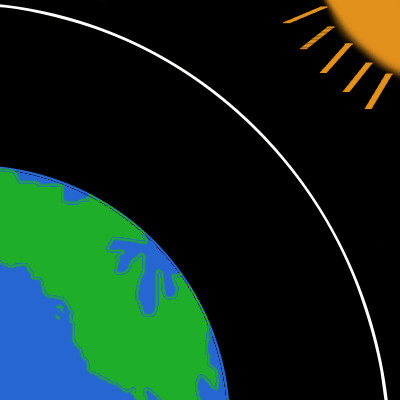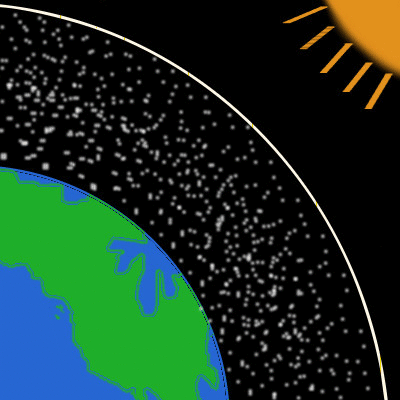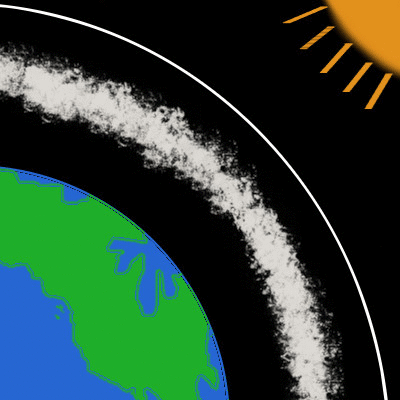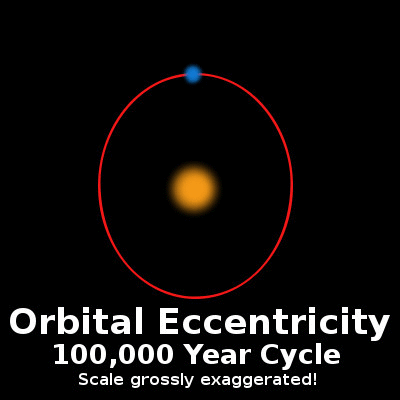A Discussion About Climate Change – Part 2: Atmosphere

It is more than just the air we breathe. It is the shield that protects and encompasses our planet. Should we battle the sun with a damaged shield?
In the first installment of this series, we took a look at cycles of planetary motion that have influenced the climate of Earth for billions of years. Be sure to read the first part for a more comprehensive explanation!
Milankovitch Summary
As a brief summary, the Milankovitch cycles collectively describe a constant fluctuation in the orbital position of Earth relative to the sun which directly affects the amount of solar radiation that Earth receives. These slight differences have encouraged significant changes in the temperature of our planet since it first formed and will continue to do so indefinitely. The cycles are natural and extremely powerful, but they occur gradually over vast time scales. They are also not the only forces that influence the climate of our planet.Earth's Atmosphere
 'Normal' atmospheric conditions where the ozone layer (white) filters out harmful UV radiation while some sunlight (orange) is absorbed by the planet and the rest is reflected back to space. Scales grossly exaggerated!
'Normal' atmospheric conditions where the ozone layer (white) filters out harmful UV radiation while some sunlight (orange) is absorbed by the planet and the rest is reflected back to space. Scales grossly exaggerated!Trapped Heat
Imagine parking a car in the sun on a hot summer day with the windows rolled up. The air in the car rapidly warms up to deadly temperatures that far exceed that of the outside air. The windows of the car allow sunlight and heat to pass into the car, but most of that energy is unable to escape. In a similar way, greenhouse gases in the atmosphere can trap heat and enhance the amount of solar radiation that the planet absorbs.Greenhouse Gases
 An atmosphere with increased greenhouse gas (grey dots) absorbs more incoming solar radiation and causes the planet to warm more rapidly. Scales grossly exaggerated!
An atmosphere with increased greenhouse gas (grey dots) absorbs more incoming solar radiation and causes the planet to warm more rapidly. Scales grossly exaggerated!Water Vapor
Water vapor is a greenhouse gas that may account for as much as 60% of the greenhouse gas warming effect observed today. The amount of water vapor that can be suspended by air is directly proportional to the air temperature. As the global temperatures increase, the capacity of water vapor that can be suspended by the air also increases. This factor makes the concentrations of other greenhouse gases even more influential, as any net increase in greenhouse gas is multiplied by the increased water vapor carrying capacity.Natural Sources
The concentration of CO2 and other greenhouse gases are influenced by several natural processes. One of the largest sources is volcanic eruptions, which is generally a mixture of carbon dioxide, methane, water vapor, and various other gases. Active tectonic plate boundaries and volcanoes worldwide are constantly emitting massive amounts of gas and dust into the atmosphere. Additionally, the process of lava and magma cooling into rock can release gases. Animals, swamps, peat bogs, and decaying organisms are natural sources of methane and carbon dioxide. Greenhouse gas sources are even found throughout the oceans.Anthropogenic Sources
It is time to address the elephant in this global room. Human activity has altered our planet and increased the concentrations of greenhouse gases. In countries like the United States, the extraction, processing, and burning of fossil fuels such as oil, natural gas, and coal has increased (often exponentially) since the industrial revolution. This has unquestionably led to an increase in the amount of CO2 in the atmosphere since the gas is released as a byproduct of fossil fuel combustion. This growing demand for electricity, the heating and cooling of buildings, and rapid transportation does not appear to be slowing any time soon.Other human activities such as livestock grazing, deforestation, chemical and aerosol production, industry, agriculture, and mining also contribute to the increasing concentrations of greenhouse gases like methane, CO2, and chlorofluorocarbon (CFCs). Fortunately, some progress has been made in recent years toward reducing the production of CFCs in the United States and other countries after it was shown that they can lead to ozone layer depletion.

Natural Carbon Sinks
Nearly three-quarters of the surface of our planet is covered by water. The ocean is the single largest CO2 sink that there is. In addition to carbon being dissolved directly by the water, there are photosynthetic organisms (algae, cyanobacteria) that respire carbon and other life that use carbon to form rigid carbonate shells. On land, any type of photosynthetic organism has the ability to fix carbon and turn CO2 into O2. This includes trees, grasses, crops, algae, shrubs, and other plants.Effects of Warming
Short-Term
Over a time scale of decades to centuries, the effects of a continued warming trend are two-fold. An increase in temperature and atmospheric water vapor will lead to increased crop yield in many places, though cycles of drought and extreme weather conditions like hurricanes will also become more common. The melting of ice in Antarctica and Greenland will cause a rise in sea level and a loss of some coastal land, but the warming trend will cause inhospitable land in the polar regions to become more temperate.Long-Term
When greater time scales are considered, the consequences of increasing greenhouse gas concentrations may be counter-intuitive. As more CO2 is dissolved by the warming oceans, the ocean waters become more acidic and less hospitable for most forms of life. In fact, the diversity of life will decrease as species struggle to adapt to the changing climate and go extinct. On time scales this great, the Milankovitch cycles discussed in part 1 start to have their own influence on global climate and muddle the blame. Ultimately, it seems that the long-term consequence of warming might be extreme cooling...Negative Feedbacks
 Increased cloud cover reflects much of the incoming solar radiation and causes the planet to cool faster. Scales grossly exaggerated!
Increased cloud cover reflects much of the incoming solar radiation and causes the planet to cool faster. Scales grossly exaggerated!The vast clouds of ash and dust propelled into the atmosphere during volcanic eruptions and other celestial events (such as meteor impacts) can help to counteract the increase in greenhouse gases by reflecting solar radiation before it reaches earth. This can cause prolonged periods of cooling that encourage the onset of ice ages.
Similarly, as global temperatures increase and as water vapor accumulates in the atmosphere, the vapor forms into clouds. An increase in cloud cover will reflect most sunlight away from the earth before it has a chance to reach the surface and contribute heat. This will lead to a cooling of the planet and in turn reduce the amount of water vapor that can remain suspended in the air.
Ocean Currents and Ice Caps
 A disruption of the flow of ocean currents and seasonal extremes can cause the formation of ice caps. The increased albedo of snow on the Earth's surface reflects solar energy. Scales grossly exaggerated!
A disruption of the flow of ocean currents and seasonal extremes can cause the formation of ice caps. The increased albedo of snow on the Earth's surface reflects solar energy. Scales grossly exaggerated!
A most excellent piece I just stumbled upon a few minutes ago... WOW!
You have found yourself a new follower in me and I already look forward to seeing more of your high quality posts among us on this platform. Upvoted, resteemed and follwed!
May the force stay with us, namaste :)
I have looked around a bit, and found these, in a post published on wattsupwiththat.com (where I found it, anyway).
This shows that the oceans have been cooling for the past 55M years.
This shows that the cooling continues in the last 10K years, as well.
Since ocean temperatures drive atmospheric temperatures (not the other way around), the Earth has been cooling. In the paper linked here, the author discusses why ice ages are getting longer, and it's because the Earth is cooling, making it more difficult to, and rare, for the Earth to warm enough to melt the ice.
Personally, being from Alaska, I've seen enough glaciers to last me. I'd really like to believe the Earth isn't going to plunge into an ice age from which it will never escape, but that's not what the author of this paper says will happen.
Rather the reverse.
Thoughts?
Thanks for sharing these thoughts! I plan to eventually address these data sets and discuss the the future models in more detail, but at a glance the first thing that I notice is that the paper is looking at deep ocean temperatures. This does not necessarily reflect the trends of atmospheric temperature or surface ocean waters. It is hard to see a time scale of decades on those graphs, but on more recent time scales the temperatures of surface ocean water seems to be mostly increasing.
Cold water from melting land ice is more dense and stratifies at the bottom of the ocean. This may be one factor contributing to the decrease in deep ocean temperatures since the end of the last ice age. While in the short-term (centuries) we seem to be in a warming trend, in the longer-term another ice-age is inevitable. Escape from that ice age also seems inevitable, as the orbital cycles of the earth will eventually thaw things out (10,000s of years).
I appreciate the conversation to stimulate my thinking on Part 3 of this series!
I invite you to follow the link to the WUWT site, as not only this paper, but numerous peer reviewed papers dealing with every aspect of climate are there, from every perspective.
The particulars you mention in your reply are discussed in this paper, as ocean upwelling cools the surface of the sea, and then sucks heat from the atmosphere, as water is much more dense than air, and holds a lot more heat.
Thanks for providing a vector for this discussion, particularly where data is welcome, as the complexity of the science leaves many questions that can be too easily glossed over, as the eyes glaze over.
Excellent follow up to your first post. The comprehensive approach you've chosen really helped me understand the multitude of implications that global warming from greenhouse gasses has on our earth. I see now why the discussion of the Milankovitch cycles was integral to this analysis.
Thank you! I am glad that this helps with understanding the complexity of the issue!
I am really looking forward to read the 3rd part. This is super well explained, and I like the fact that you try hard to be objective.
Thank you for your praise! The 3rd part is going to be really fun to write; the challenge will be not losing readers with the data!
Cool - great analysis
Thanks!
@originalworks
The @OriginalWorks bot has determined this post by @gra to be original material and upvoted it!
To call @OriginalWorks, simply reply to any post with @originalworks or !originalworks in your message!
To enter this post into the daily RESTEEM contest, upvote this comment! The user with the most upvotes on their @OriginalWorks comment will win!
For more information, Click Here!
Special thanks to @reggaemuffin for being a supporter! Vote him as a witness to help make Steemit a better place!
Congratulations @gra! You have completed some achievement on Steemit and have been rewarded with new badge(s) :
Click on any badge to view your own Board of Honor on SteemitBoard.
For more information about SteemitBoard, click here
If you no longer want to receive notifications, reply to this comment with the word
STOP